
A larva is a distinct juvenile form many animals undergo before metamorphosis into their next life stage. Animals with indirect development such as insects, amphibians, or cnidarians typically have a larval phase of their life cycle.

The caddisflies, or order Trichoptera, are a group of insects with aquatic larvae and terrestrial adults. There are approximately 14,500 described species, most of which can be divided into the suborders Integripalpia and Annulipalpia on the basis of the adult mouthparts. Integripalpian larvae construct a portable casing to protect themselves as they move around looking for food, while annulipalpian larvae make themselves a fixed retreat in which they remain, waiting for food to come to them. The affinities of the small third suborder Spicipalpia are unclear, and molecular analysis suggests it may not be monophyletic. Also called sedge-flies or rail-flies, the adults are small moth-like insects with two pairs of hairy membranous wings. They are closely related to the Lepidoptera which have scales on their wings; the two orders together form the superorder Amphiesmenoptera.

The Integripalpia are a suborder of Trichoptera, the caddisflies. The name refers to the unringed nature of maxillary palp's terminal segment in the adults. Integripalpian larvae construct portable cases out of debris during the first larval instar, which are enlarged through subsequent instars. These cases are often very specific in construction at both the family and genus level.

Limnephilidae is a family of caddisflies with about 100 genera. They belong to the main lineage of case-constructing caddisflies, the Integripalpia or tube-case caddisflies. The Limnephilidae is one of the most species-rich Trichoptera families of northern temperate regions, but only a few are known from tropical areas and the Southern Hemisphere. For this reason they are often known as northern caddisflies.

The Ecnomidae are a family of caddisflies comprising 9 genera with a total of 375 species.

The Psychomyiidae are a family of tube-making caddisflies. Members of this family are typically very similar to polycentropodids, most of them can be differentiated by the spur formula is 2-4-4, thyridial cell short, absence of the forewing fork I, and hindwing forks I and IV. Male genitalia has elongate preanal appendages, and reduced tergum IX. The larvae differ by the submental sclerites separated, foretrochantin broad, and the pupal mandible apex whip-like. Larvae construct long silken galleries.
The Glossosomatidae are a family of the class Insecta and order Trichoptera.The family contains 23 genera in three subfamilies. In the US alone, there are 76 spp. in 6 different genera.
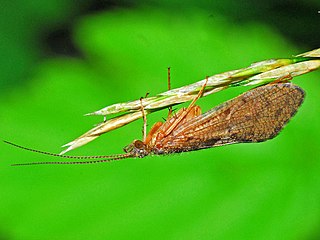
Rhyacophila is a genus of caddisflies in the family Rhyacophilidae. There are at least 640 described species in Rhyacophila.
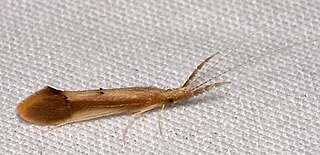
Triaenodes is a genus of long-horned caddisflies in the family Leptoceridae. There are at least 170 described species in Triaenodes.

Athericidae is a small family of flies known as water snipe flies or ibis flies. They used to be placed in the family Rhagionidae, but were removed by Stuckenberg in 1973. They are now known to be more closely related to Tabanidae. Species of Athericidae are found worldwide.
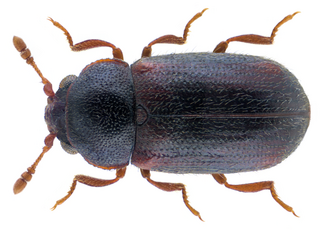
Sphindidae is a family of beetles, in the suborder Polyphaga. They are also known as slime mold beetles due to their exclusive feeding on slime molds during adult and larval stages, other aspects of their life history are obscure. Palaeontological discoveries since 2015 have added to the geologic history of Sphindidae, including the discovery of Libanopsis, placed in the extinct subfamily Libanopsinae.
Agapetus montanus is a species of caddisfly. It is endemic to the north-western states of the United States of America.

Brachycentridae is a family of humpless casemaker caddisflies in the order Trichoptera. It is found in North America, Europe, and Asia. Georg Ulmer first described it in Germany in 1903 as a subfamily of Sericostomatidae. The type genus for Brachycentridae is Brachycentrus J. Curtis, 1834.

Hydropsyche is a genus of netspinning caddisflies in the family Hydropsychidae. There are at least 260 described species in the genus Hydropsyche.

Stenophylacini is a tribe of northern caddisflies in the family Limnephilidae. There are at least 20 genera and 190 described species in Stenophylacini.
Agapetus rossi is a species of little black caddisfly in the family Glossosomatidae. It is found in North America.
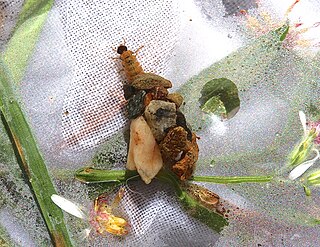
Glossosoma nigrior is a species of little black caddisfly in the family Glossosomatidae. It is found in North America.
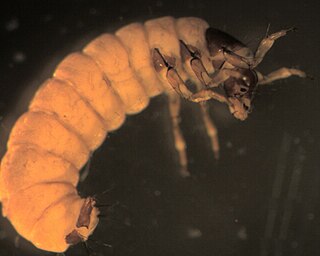
Glossosoma is a genus of little black caddisflies in the family Glossosomatidae. There are more than 110 described species in Glossosoma.















